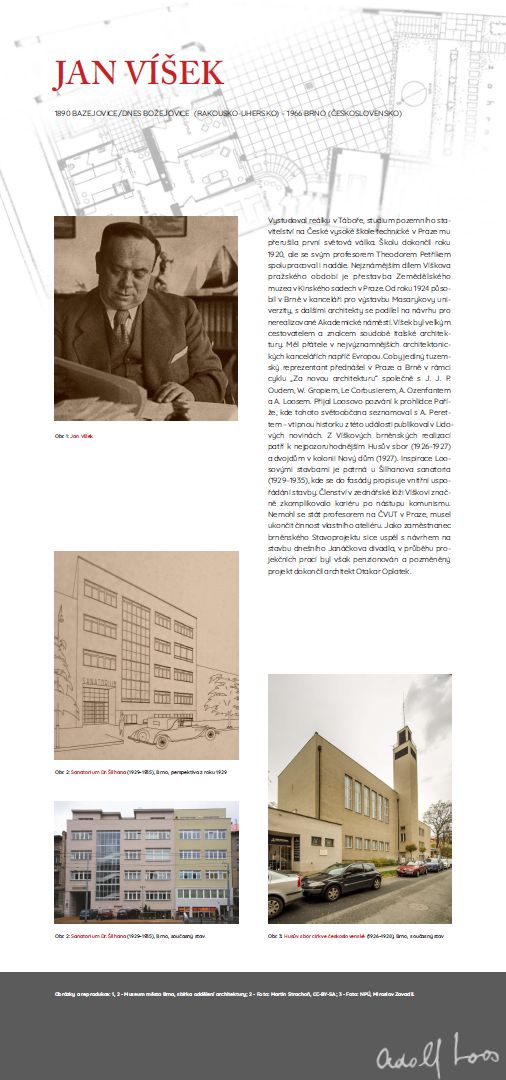Následovníci Adolfa Loose / Adolf Loos Followers
Virtuální prohlídka výstavy / virtual tour of the exhibition
Titul | Adolf Loos | Felix Augenfeld | Friedrich Ehrmann | Paul Engelmann | Jacques Groag | Alfons Hetmanek | Heinrich Kulka | Karel Lhota | Margarete Schütte-Lihotzky | Walter Sobotka | Kurt Unger | Jan Víšek | Rudolf Wels | Ernst Wiesner
Jan Víšek
1890 BAZEJOVICE/DNES BOŽEJOVICE (RAKOUSKO-UHERSKO) – 1966 BRNO (ČESKOSLOVENSKO)
|
Vystudoval reálku v Táboře, studium pozemního stavitelství na České vysoké škole technické v Praze mu přerušila první světová válka. Školu dokončil roku 1920, ale se svým profesorem Theodorem Petříkem spolupracoval i nadále. Nejznámějším dílem Víškova pražského období je přestavba Zemědělského muzea v Kinského sadech v Praze. Od roku 1924 působil v Brně v kanceláři pro výstavbu Masarykovy univerzity, s dalšími architekty se podílel na návrhu pro nerealizované Akademické náměstí. Víšek byl velkým cestovatelem a znalcem soudobé italské architektury. Měl přátele v nejvýznamnějších architektonických kancelářích napříč Evropou. Coby jediný tuzemský reprezentant přednášel v Praze a Brně v rámci cyklu „Za novou architekturu“ společně s J. J. P. Oudem, W. Gropiem, Le Corbusierem, A. Ozenfantem a A. Loosem. Přijal Loosovo pozvání k prohlídce Paříže, kde tohoto světoobčana seznamoval s A. Perettem – vtipnou historku z této události publikoval v Lidových novinách. Z Víškových brněnských realizací patří k nejpozoruhodnějším Husův sbor (1926–1927) a dvojdům v kolonii Nový dům (1927). Inspirace Loosovými stavbami je patrná u Šilhanova sanatoria (1929–1935), kde se do fasády propisuje vnitřní uspořádání stavby. Členství v zednářské lóži Víškovi značně zkomplikovalo kariéru po nástupu komunismu. Nemohl se stát profesorem na ČVUT v Praze, musel ukončit činnost vlastního ateliéru. Jako zaměstnanec brněnského Stavoprojektu sice uspěl s návrhem na stavbu dnešního Janáčkova divadla, v průběhu projekčních prací byl však penzionován a pozměněný projekt dokončil architekt Otakar Oplatek. |
After grammar school in Tábor he went on to study civil engineering at the Czech Technical University in Prague, but this was interrupted by the First World War. He graduated in 1920, but continued to work with his professor Theodor Petřík. The most work of Víšek's Prague period is the remodelling of the Agricultural Museum in Kinský sady in Prague. From 1924 he worked in Brno in the office for the construction of Masaryk University campus where, together with other architects, he participated in the design for the Academic Square, though this was never built. Víšek was a great traveller and connoisseur of contemporary Italian architecture. He had friends in the most important architectural offices across Europe. As the only domestic representative, he lectured in Prague and Brno as part of the cycle "For New Architecture" together with J. J. P. Oud, W. Gropius, Le Corbusier, A. Ozenfant and A. Loos. He accepted Loos' invitation to visit Paris, where he introduced this global citizen to A. Perette - he published a funny story from this event in Lidové noviny newspaper. Among Víšek's Brno creations, the Hus Church (1926–1927) and the semi-detached houses in the Nový dům colony (1927) are among the most remarkable. The influence of Loos' buildings is evident in Šilhan's Sanatorium (1929–1935), where the internal layout of the building permeates into the facade. Víšek’s membership in a Masonic lodge greatly complicated his career after the onset of communism. He could not become a professor at the Czech Technical University in Prague and he had to close his own studio. As an employee of the Brno Stavoprojekt, he succeeded with the design for today's Janáček Theatre, but had to retire during the ongoing design work and the modified project was completed by the architect Otakar Oplatek. |
